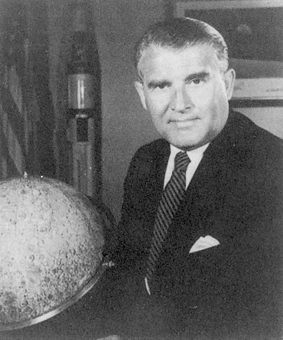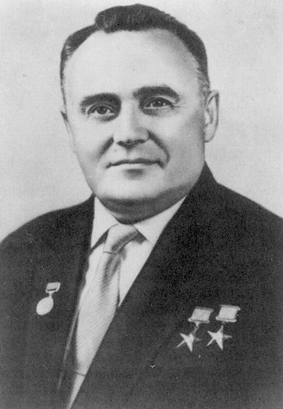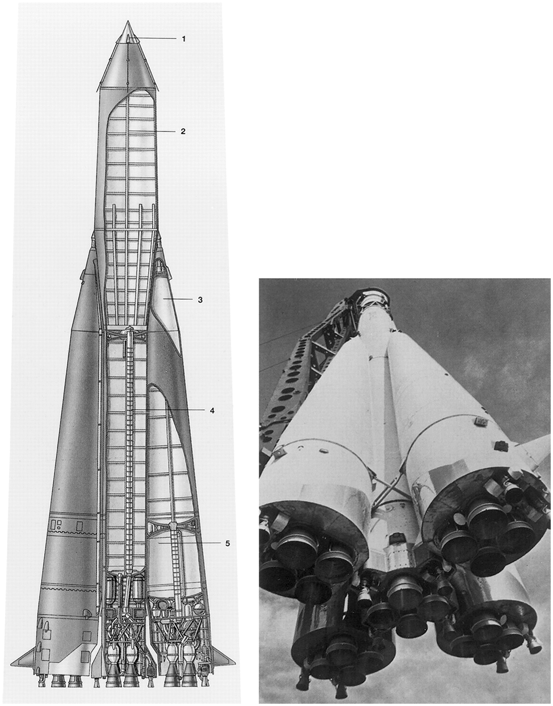Fig. 23.1
Left: Konstantin Edvardovich Tsiolkovsky (1857–1935), an almost deaf mathematics teacher in provincial Russia but a remarkable space visionary (from Tass-Sovfoto). Right: sketch of a spacecraft made by Tsiolkovsky in 1883. (From Ref. [14])
Tsiolkovsky’s extraordinary vision and imagination are illustrated in his description of the liftoff of an imaginary spacecraft (Ref. [7], p. 99). Recall that this was written at the end of the nineteenth century and beginning of the twentieth century, when the Wright brothers were experimenting with the first aircraft.
The signal is given; the explosion, attended by a deafening noise, starts setting off. The rocket shakes and takes off. We have the sensation of terrible heaviness. My weight has increased tenfold. I am knocked down to the floor, severely injured and perhaps have even been killed—can there be any talk of observations? There are ways of standing up to this terrible weight, but only in a, so to say, compact form or being submerged in a liquid. [Volunteers have now tolerated 30 G during water immersion [4]]
Even when submerged in liquid we will hardly be inclined to observe anything outside. Be all that as it may, the gravity in the rocket has apparently increased tenfold since takeoff. We would be informed of this by a spring balance or a load gauge by the accelerated swinging of a pendulum (some three times faster) [the period of a pendulum is inversely proportional to the square root of G], by the faster fall of bodies, by the diminished size of droplets (their diameter decreasing tenfold), by all things carried aboard the rocket becoming heavier, and many other phenomena.
Tsiolkovsky gave an equally imaginative account of the sensation of weightlessness that he predicted would occur when the spacecraft reached orbit and the engines were turned off (Ref. [7], p. 100).
The awful gravity that we experience will last until the explosion and the noise come to an end. Then, as dead silence sets in, the gravity pull will diminish instantaneously, just as it appeared. We are now out beyond the limits of the atmosphere at an altitude of 575 km. The gravity pull did not only diminish in force but vanished completely without a trace; we no longer even experience the terrestrial gravitation that we are accustomed to just as we accustomed to the air, though it is not at all so necessary as the latter. The altitude of 575 km is very little, it is almost at the surface of the Earth, and the gravity should have diminished ever so slightly. And that actually is the case. But we are dealing with relative phenomena, and for them there is no gravity.
The force of terrestrial gravitation exerts its influence on both the rocket and bodies in it in the same way. For this reason there is no difference in the motion of the rocket and the bodies in it. They are carried along by the same stream, the same force, and, as far as the rocket is concerned, there is no gravity.
There are many things that convince us of this. All objects in the rocket, that were not attached, have left their places and are hanging in the rocket’s air, out of contact with anything; and if they touch something, they do not exert any pressure on each other or on the support. We ourselves do not touch the floor and can have any position and be in any direction: we can stand on the floor, on the ceiling or on the wall; we can stand perpendicularly or have an inclined attitude; we float in the middle of the rocket like fish but without any effort whatsoever, and we do not come in contact with anything; no object exerts pressure on any other if they are not pressed together.
Water does not pour from a decanter, a pendulum does not swing and hangs to the side. An enormous mass hung from the hook of a spring balance does not make the spring taut—it always indicates zero. Lever scales are also useless: the balance beam takes up any position, quite irrespective of and indifferent to the equality or inequality of the weights in the pans. Gold cannot be sold by weighing its mass. Conventional ways of measuring mass cannot be employed here.
Subsequent to Tsiolkovsky’s theoretical studies, several rocket pioneers were active in the 1920s and 1930s. In 1926, the American Robert Hutchings Goddard (1882–1945) launched the first liquid-propelled rocket at his Aunt Effie’s farm in Auburn, Massachusetts, having previously published his classical treatise A Method of Reaching Extreme Altitudes in 1919 [3]. However, many of his ideas were ridiculed in the New York Times and other quarters, and he largely retired from the public eye to work on his ideas in relative seclusion. Although he offered his ideas to the military in World War II, there was little interest and he worked on jet-assisted take-off devices for aircraft.
After his death, the importance of his work was acknowledged, a million dollar settlement was made for the use of his patents, and his name is perpetuated in the Goddard Spaceflight Center in Greenbelt, Maryland.
In Germany, the potential value of rockets was more clearly seen, and Herman Julius Oberth (1894–1989) formulated many of the technical problems of spaceflight, but even there many of his ideas were dismissed as fantasies. Later, he moved to Peenemünde to work with Wernher von Braun and eventually came to the United States.
23.2 Wernher von Braun and Peenemünde
Any historical survey of manned spaceflight must include a section on Wernher von Braun (1912–1977) because of the critical developments in rocketry that took place in Peenemünde from 1936 to 1945. Although von Braun (Fig. 23.2) did not directly influence the Soviet space program, remnants of rockets were examined by Soviet engineers, and, as described below, one of the first rockets in the Soviet space program was an identical copy of the main Peenemünde rocket.

Fig. 23.2
Wernher von Braun (1912–1977) who developed the A4 rocket in Peenemünde, Germany during World War II. This had a great influence on both the Soviet and U.S. space programs. (From Ref. [14])
Von Braun assisted Oberth in work on liquid-propelled rockets in a German rocket society in 1930; however, a few years later, the work was taken over by the army under Gen. Walter Dornberger. The group worked first near Berlin but later moved to Peenemünde in northwest Germany on the Baltic Sea where there was ample space. The most important development was the A4 rocket (Fig. 23.3), the first rocket to demonstrate the potential of suborbital flight, partly because of its enormous thrust and also the development of a sophisticated guidance system. In the television documentary Spaceflight [12], there are dramatic interviews with Wernher von Braun and Krafft Ehricke describing the first successful launch of the A4. The first toppled over to be followed by an enormous explosion, the second had better luck but went out of control, and the third streaked skyward until it was out of sight. Everybody immediately recognized that this was the beginning of a new age when humans would enter space. Ehricke vividly describes the exhilaration of the launch team following the first successful flight.

Fig. 23.3
A4 rocket developed by Wernher von Braun and his coworkers. This was the first successful suborbital rocket and played an important role in the development of the Soviet manned space program. (From Ref. [17])
At the end of World War II, von Braun and several others from the Peenemünde facility were transferred to the United States, where they played crucial roles in the development of the American space program. All that remained of the A4 rockets in Peenemünde was systematically destroyed, but some of the remnants were studied by Soviet rocket experts. Here is a graphic description of what Boris Chertok, one of the engineers, found (Ref. [5], p. 65)
So I come into this hall. Several hours before me our engine man, Alexei Mikhailovich Isaev—one of the future stars of our rocket technology—was let in. I see the lower part of his body and his legs sticking out of the rocket engine nozzle, while his head is somewhere inside…. I approach Bolkhovitinov.
“What is this?”
“This is what cannot be,” he replies …. Understand, one of our most talented aircraft designers simply did not believe that in wartime conditions it would be possible to develop such a huge and powerful rocket engine. We had at the time liquid engines of our experimental rocket planes with thrusts of hundreds of kilograms. One and one half tons was the limit of our dreams. Yet here we quickly calculated, based on the nozzle dimensions, that the engine thrust was at least 20 t.
In fact, the A4 rocket had been redesignated as the V-2 (for Vengeance-2), and many were launched against London with terrifying results. The V-2 had a gross weight of nearly 13 t and could carry a 1-t payload 200 km. It was the first missile to incorporate a cryogenic turbo pump and the first to use a sophisticated guidance system.
23.3 Sergei Korolev, the Principal Architect of the Soviet/Russian Manned Space Program
Sergei Pavlovich Korolev (1907–1966, Fig. 23.4) was the genius who achieved preeminence of the Soviet/Russian manned space program from its beginning to the mid-1960s. He was born in Zhitomir in Ukraine near Kiev, and, while in his teens, he built and flew gliders. In 1926, he enrolled in the Moscow Technical High School where one of his lecturers was Tupolev, the famous Russian aircraft designer. Korolev became interested in rocketry and in 1933 was responsible for the first flight of a liquid-fuelled rocket in the Soviet Union. During 1936–1938, Korolev and his talented colleague, Valentin Glushko, used rocket engines to propel gliders.

Fig. 23.4
Sergei Pavlovich Korolev (1907–1966) who was the Chief Designer of the early Soviet manned space program. (From Ref. [14])
However, in 1938, disaster befell Korolev, and the subsequent story is one that could only have occurred in the Soviet Union. He was arrested by Stalin’s regime on a trumped-up charge as an “enemy of the people” and sentenced to 10 years of hard labor. First, he was incarcerated in one of the most dreaded prisons, Kolmya, in far eastern Siberia. He spent 5 months in the winter, digging in a surface gold mine, and many of his fellow prisoners died. Later, Korolev was moved to Moscow where he was held under house arrest in a prison for scientists known as a “sharaga,” where he was allowed to do some engineering design work. This was the type of institution described by Aleksandr Solzhenitsyn in The Gulag Archipelago [16]. One of his fellow prisoners was Tupolev. Korolev was in prison for a total of about 7 years but was eventually released after World War II when the Soviets recognized the importance of developing a missile program and realized that he was one of their most talented rocket engineers. In 1944 Korolev was discharged from prison and his convictions were expunged, and in 1945 he was commissioned as a colonel in the Red Army. Amazingly, he then continued to work until his death 21 years later at breakneck speed and appeared to harbor no resentment toward the regime. On the contrary, according to a sequence in one of the television documentaries [11], he told Gagarin and Leonov shortly before his death of his complete loyalty and devotion to the Soviet Union.
Initially, Korolev was asked by Stalin to build a replica of the German A4 rocket that had been developed in Peenemünde (Fig. 23.3). Korolev apparently argued that he could come up with a better design, but Stalin was suspicious of technical innovation and wanted to start with something that would certainly work. Korolev complied and produced a replica of the A4 within 2 years. He then went on to mastermind the Soviet rocket and space systems, and his successes were spectacular (Table 23.1). By 1957, he had developed the R-7 booster (Fig. 23.5), which propelled a 5-t dummy warhead 6400 km to Kamchatka, thus making it the world’s first intercontinental ballistic missile (ICBM). This was followed by the launch of Sputnik 1, the world’s first artificial satellite; the launch of the dog Laika, the first living being in space; and his most spectacular success, the launch of Yuri Gagarin, the first human being in space. Subsequent successes included the first woman in space, Valentina Tereshkova; the first three-person crew in space; and the first extravehicular activity (EVA). This was an amazing catalog of firsts.
Table 23.1
“Firsts” in the soviet space program attributable to Sergei Korolev
< div class='tao-gold-member'>
Only gold members can continue reading. Log In or Register to continue
Stay updated, free articles. Join our Telegram channel

Full access? Get Clinical Tree



